
“No revolutionary movement is complete without its poetic expression.
[Without] It is the dogma of a few and not the faith of the multitude.”
James Connolly, Irish rebel (1907)
On November 20, 2013, the dean of painting at Silpakorn Fine Arts University, Ajarn Amrit Chuswan, organized an event where about 100 Thai artists gathered at the main protest site on Ratchadamnoen Road to express their feelings about the current situation in Thailand. Ajarn Amrit explained the main goal was to teach the history from the massacre of Thai university students in 1973 to the present-day protests, because the education system does not fully cover this history.
Artists, including painters, musicians, poets, other writers and performance artists, are a vital part of all social change movements. They are on the front lines and are not featured solely for entertainment purpose. In many cases, artists are the leaders.
Francois May is a photographer from France who captured the images presented below. We present not only the art but also some of the protesters who sought comfort from the presence of the art. We were not able to identify all the artists’ names, and in some cases the panels photographed below were the result of a collaboration of several artists.
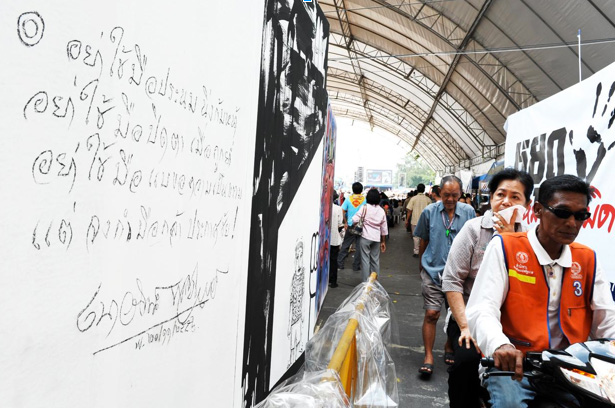
The poem on the mural at left is written by Thai National Artist Naowarat Pongpaiboon. A translation provided by The Nation reporter Phoowadon Duangmee follows:
“Don’t use your hands to pay obeisance.
Don’t use your hands to cover your eyes blind.
Don’t use your hands to beg for justice
Instead, punch your hands in the air and reach for victory.”
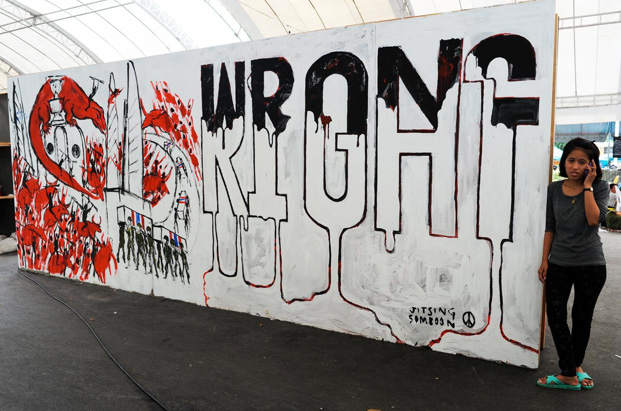
Artist: Jitising Somboon. The left side of her canvas depicts red-shirt protests in 2010.
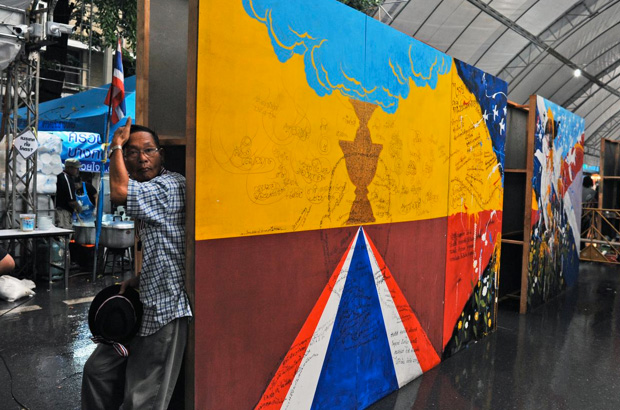
This piece represents the massacre of more than 100 Thai university students during their pro-democracy protests on October 14, 1973. The object that looks like a chalice at the top of the road is, in fact, situated on top of the Democracy Monument and represents the Thai Constitution and rule of law. A group of Silpakorn painting professors created this piece.
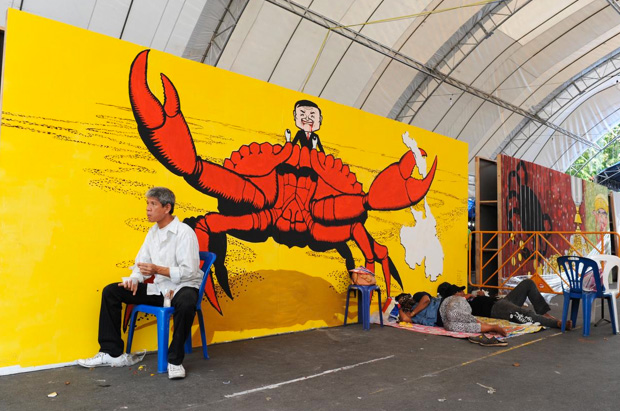
The nickname of Thaksin Shinawatra’s younger sister, Yingluck, is Poo. In the Thai language, Poo means crab. She is the nominal prime minister of Thailand. In the crab’s left claw is Thailand depicted upside down. This work was created by a Silpakorn Fine Arts University professor and seven of his students.

On the left is a painting by Vasan Sitthiket, one of the best-known activists and artists in Thailand. The female figure in gold is in the shape of the country. Thaksin and his sister Yingluck are at the top left and right, respectively. The caption reads, roughly: “Enough eating here! Stop Abusing Thailand!”
The painting to the right is by Thai artist Narodom.
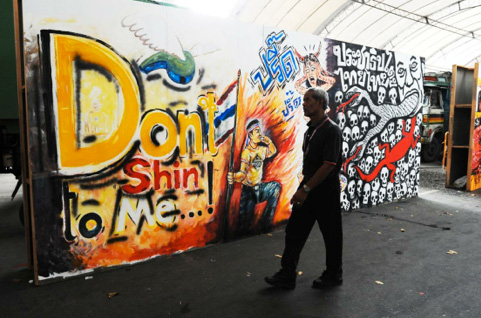
The two pieces shown above are by unsigned artists. The “Shin” on the left is a play on the family name of Thaksin Shinawatra. On the right is Thaksin with lizards coming out of his mouth and a caption that reads: “Democracy, Thai style.”
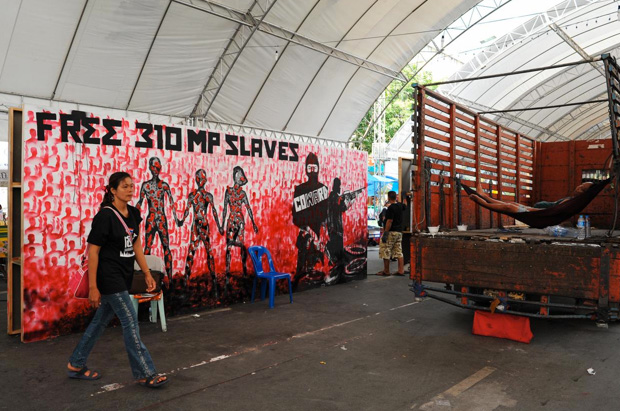
This piece depicts the red-shirt demonstrations of 2010, especially on the right side, showing the nefarious “men in black” who hid among the red-shirted protestors to fire at the military. “MP Slaves” refers to the members of the Thaksin-controlled Phuea Thai Party, which voted to grant amnesty to Thaksin as well as everyone criminally culpable in the events of 2010 and who provided amnesty to all those involved in corruption cases since 2004. This would absolve Thaksin and return his money. It also would negate more than 25,000 other corruption cases.
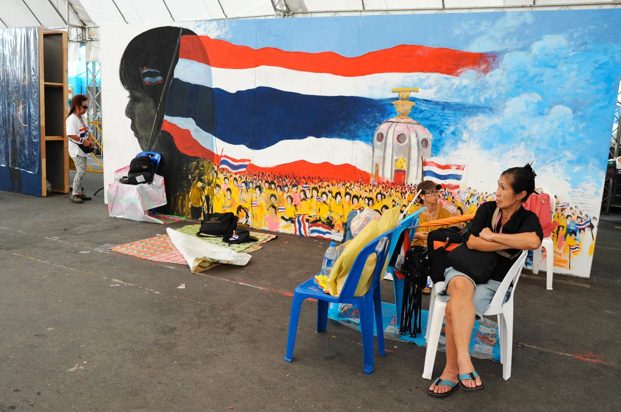
A protester relaxes in front of art representing the yellow-shirt protests in 2008. Artist unknown.
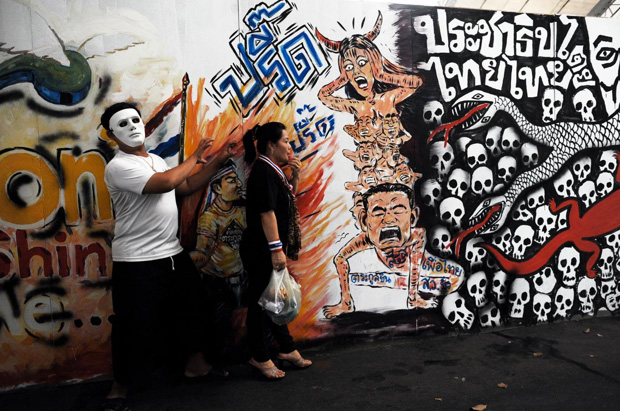
A masked demonstrator acts out.
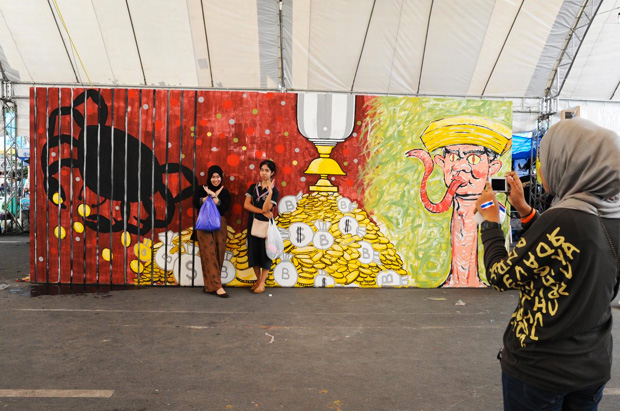
Artists unknown. Once again, Poo appears on left, with her fugitive brother on the right. Above the money is the symbol of rule of law upside down.
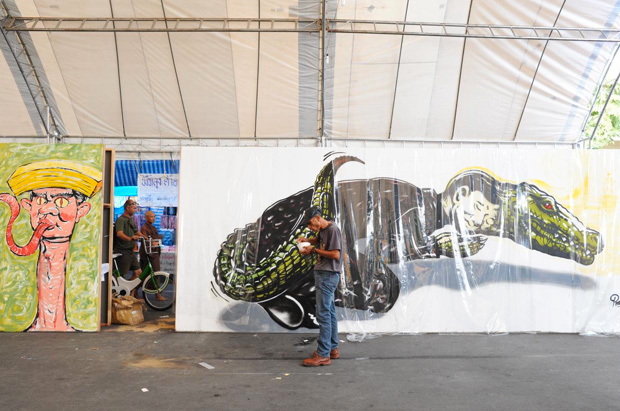
A protester enjoying a bowl of lizard (?) soup. In the painting, Thaksin sleeps peacefully inside the lizard.
At the protest site, I spoke with a Thai woman in her early 40s about why she attends the protests. She said, “I love my country; I love my religion; I love my king; corruption makes my heart sick because Thailand will collapse if we don’t change.” She was not interested in any of the political parties; she wished only that this protest would begin to destroy corruption. She has slept on the pavement for the past 11 days and is willing to stay until progress is made to stop corruption.
Her attitude is not unlike that of so many others we witnessed on November 24, 2013, when nearly 1 million demonstrators gathered on Ratchadamnoen Road to demand an end to Thakinism and corruption.
Our most important fundraising appeal of the year
December is the most critical time of year for Truthout, because our nonprofit news is funded almost entirely by individual donations from readers like you. So before you navigate away, we ask that you take just a second to support Truthout with a tax-deductible donation.
This year is a little different. We are up against a far-reaching, wide-scale attack on press freedom coming from the Trump administration. 2025 was a year of frightening censorship, news industry corporate consolidation, and worsening financial conditions for progressive nonprofits across the board.
We can only resist Trump’s agenda by cultivating a strong base of support. The right-wing mediasphere is funded comfortably by billionaire owners and venture capitalist philanthropists. At Truthout, we have you.
We’ve set an ambitious target for our year-end campaign — a goal of $230,000 to keep up our fight against authoritarianism in 2026. Please take a meaningful action in this fight: make a one-time or monthly donation to Truthout before December 31. If you have the means, please dig deep.